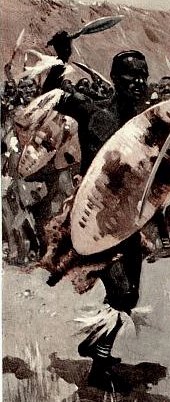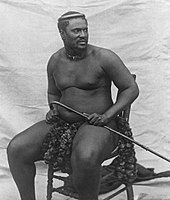Zulu Kingdom
Kingdom of Zululand KwaZulu | |||||||||||||
|---|---|---|---|---|---|---|---|---|---|---|---|---|---|
| 1816–1897 | |||||||||||||
 Location of the Zulu Kingdom, c. 1890 (red) (borders in flux) | |||||||||||||
| Status | Protectorate of the United Kingdom 1887–1897 | ||||||||||||
| Capital | kwaBulawayo; uMgungundlovu; Ulundi | ||||||||||||
| Common languages | isiZulu | ||||||||||||
| Religion | Zulu religion | ||||||||||||
| Government | Monarchy | ||||||||||||
| King | |||||||||||||
• 1816–1828 | Shaka | ||||||||||||
• 1828–1840 | Dingane | ||||||||||||
• 1840–1856 | Mpande | ||||||||||||
• 1856–1884 | Cetshwayo | ||||||||||||
• 1884–1887 | Dinuzulu | ||||||||||||
| History | |||||||||||||
• Death of Dingiswayo | 1818 | ||||||||||||
• Accession of Shaka | 1816 | ||||||||||||
| 1818 | |||||||||||||
| 1820 | |||||||||||||
| 1838 | |||||||||||||
| 1879 | |||||||||||||
• British protectorate | 1887 | ||||||||||||
• to Natal | 1897 | ||||||||||||
| Area | |||||||||||||
| 1822[1] | 207,000 km2 (80,000 sq mi) | ||||||||||||
| Population | |||||||||||||
• 1828 | 250,000 | ||||||||||||
| Currency | Cattle | ||||||||||||
| |||||||||||||
| Today part of | South Africa | ||||||||||||
The Zulu Kingdom (/ˈzuːluː/ ZOO-loo, Zulu: KwaZulu), sometimes referred to as the Zulu Empire or the Kingdom of Zululand, was a monarchy in Southern Africa. During the 1810s, Shaka established a standing army that consolidated rival clans and built a large following which ruled a wide expanse of Southern Africa that extended along the coast of the Indian Ocean from the Tugela River in the south to the Pongola River in the north.
A bitter civil war in the mid-19th century erupted which culminated in the 1856 Battle of Ndondakusuka between the brothers Cetshwayo and Mbuyazi. In 1879, a British force invaded Zululand, beginning the Anglo-Zulu War. After an initial Zulu victory at the Battle of Isandlwana in January, the British regrouped and defeated the Zulus in July during the Battle of Ulundi, ending the war. The area was absorbed into the Colony of Natal and later became part of the Union of South Africa.
History
Rise under Shaka

Shaka's clan at first numbered no more than a few thousands, but eventually grew in size to 45,000 after absorbing neighbouring clans. His military reforms included new battle techniques, training, and tough discipline, as well as the replacement of long-throwing spears in exchange for the more effective short-stabbing spears. Conscripted men were segregated from the rest of Zulu society to be trained as an organized standing army called the amabutho.[3]
The alliance under his leadership survived Zwide's first assault at the
An offshoot of the Zulu, the amaNdebele, better known to history as the
. East of the green area was the land of the Mpondo under their king Faku and their brother clan the Mpondomise. Faku created a No Man's Land as a buffer between his kingdom and the Zulu.Dingane's reign

Shaka was succeeded by
Clashes with Voortrekkers

In the
Dingane asked that Retief and his party retrieve some cattle stolen from him by a local chief as part of the treaty for land for the Boers. This Retief and his men did, returning on 3 February 1838. The next day, a treaty was signed, wherein Dingane ceded all the land south of the
Retief and his men were overpowered, taken to the nearby hill kwaMatiwane, and executed. Some allege that they were killed for withholding some of the cattle they recovered, but it is likely that the deal was a plot to overpower the Voortrekkers.[citation needed] Dingane's army then attacked and massacred a group of 250 Voortrekker men, women and children camped nearby. The site of this massacre is today called Weenen, (Dutch for "to weep"). The remaining Voortrekkers elected a new leader, Andries Pretorius, who led a successful defence of the Voortrekker position from the Zulu forces and Dingane at the Battle of Blood River on 16 December 1838, when 15,000 Zulu impis (warriors) attacked a group of 470 Voortrekker settlers led by Pretorius.[citation needed]
Mpande's reign

Following his defeat, Dingane burned his royal household and fled north.
Following the campaign against Dingane, in 1839 the Voortrekkers, under Pretorius, formed the
In 1843, Mpande ordered a purge of perceived dissidents within his kingdom. This resulted in numerous deaths, and the fleeing of thousands of refugees into neighbouring areas (including the British-controlled
Cetshwayo's reign
At this time, a battle for the succession broke out between two of Mpande's sons, Cetshwayo and Mbuyazi. This culminated in 1856 with the Battle of Ndondakusuka, which left Mbuyazi dead. Cetshwayo then set about usurping his father's authority. When Mpande died of old age in 1872, Cetshwayo took over as ruler.
British Conquest

On 11 December 1878, with the intent of instigating a war with the Zulu, Sir Henry Bartle Frere, on his own initiative and without the approval of the British government, presented an ultimatum to the Zulu king Cetshwayo in terms with which he could not possibly comply:[10] that the Zulu army be disbanded and the Zulus accept a British resident. British forces crossed the Tugela river at the end of December 1878. Initially, the British suffered a heavy defeat at the Battle of Isandlwana on 22 January 1879 where the Zulu army killed more than 1,000 British soldiers in a single day.
The Zulu deployment at Isandhlwana showed the well-organized tactical system that had made the Zulu kingdom successful for many decades. This constituted the worst defeat the British army had ever suffered at the hands of a native African fighting force. The defeat prompted a redirection of the war effort, and the British, though outnumbered, began winning small engagements and later larger setpiece encounters. The fighting culminated in the Siege of Ulundi, the Zulus' capital city, and the subsequent defeat of the Zulu Kingdom.
Division and the death of Cetshwayo

Cetshwayo was captured a month after his defeat, and then exiled to Cape Town. The British passed rule of the Zulu kingdom onto 13 "kinglets", each with his own subkingdom. Conflict soon erupted between these subkingdoms, and in 1882, Cetshwayo was allowed to visit England. He had audiences with Queen Victoria and other famous personages before being allowed to return to Zululand to be reinstated as king.[8]
In 1883, Cetshwayo was put in place as king over a buffer reserve territory, much reduced from his original kingdom. Later that year, however, Cetshwayo was attacked at Ulundi by Zibhebhu, one of the 13 kinglets. Cetshwayo was wounded and fled. Cetshwayo died in February 1884, possibly poisoned. His son, Dinuzulu, then 15, inherited the throne.[8]
The academic Roberto Breschi notes that Zululand had a flag from 1884 to 1897 but this is pure conjecture as A.P. Burgers notes in his book.[11] It consisted of three horizontal bands in equal width of gold, green and red.
Dinuzulu's reign and exile

Dinuzulu made a pact with the
Dinuzulu's son Solomon kaDinuzulu was never recognised by South African authorities as the Zulu king, only as a local chief, but he was increasingly regarded as king by chiefs, by political intellectuals such as John Langalibalele Dube and by ordinary Zulu people. In 1923, Solomon founded the organisation Inkatha YaKwaZulu to promote his royal claims, which became moribund and then was revived in the 1970s by Mangosuthu Buthelezi, chief minister of the KwaZulu bantustan. In December 1951, Solomon's son Cyprian Bhekuzulu kaSolomon was officially recognised as the Paramount Chief of the Zulu people, but real power over ordinary Zulu people lay with South African government officials working through local chiefs who could be removed from office for failure to cooperate.[8]
Recent history
| Historical states in present-day South Africa |
|---|
 |
|
|
KwaZulu Bantustan
KwaZulu was a bantustan in South Africa, intended by the apartheid government as a semi-independent homeland for the Zulu people. The capital was moved from Nongoma to Ulundi in 1980.
It was led until its abolition in 1994 by Chief
The name kwaZulu translates roughly as Place of Zulus, or more formally Zululand.
Contemporary Zululand
The area that was once the Zulu Kingdom is currently part of South Africa's
See also
- Zulu military system
- Zulu Civil War
- Anglo-Zulu War
- List of Zulu kings
- Postage stamps and postal history of Zululand
- Nguni stick-fighting
References
- ^ JSTOR 24940454. Retrieved 7 July 2020.
By 1822 he had made himself master over 80,000 square miles
- ^ Wilkinson, Stephan (14 March 2017). "Shaka Zulu: Africa's Napoleon?". HistoryNet. Retrieved 27 May 2020.
- ^ ISBN 978-1-61039-459-8.
- ^ "Mfecane". Encyclopaedia Britannica.
- ISBN 9780195015621.
- ^ Charters, R. A. (Major, Royal Artillery) (1839). "Notices of the Cape And Southern Africa, Since The Appointment, As Governor, Of Major-Gen. Sir Geo. Napier". United Service Journal and Naval and Military Magazine. 1839, Part III (September, October, November). London: Henry Colburn: 19–25, 171–179, 352–359.
{{cite journal}}: CS1 maint: numeric names: authors list (link) - ISBN 978-0-307-42518-8.
- ^ a b c d e f "Zulu Kingdom". 17 October 2016.
- ^ Martin Meredith, Diamonds Gold and War, (New York: Public Affairs, 2007):5
- ^ Knight, Ian (2004). Zulu War. Osprey. p. 11.
- ^ Conjectural flag of Zululand (1884–1897) by Roberto Breschi taken from The South African Flag Book by A.P.Burgers
Further reading
- Bryant, Alfred T. (1964). A History of the Zulu and Neighbouring Tribes. Cape Town: C. Struik. p. 157.
- Cana, Frank Richardson (1911). . Encyclopædia Britannica. Vol. 28 (11th ed.). pp. 1050–1055.
- Morris, Donald R. (1965). The Washing of the Spears: the Rise of the Zulu Nation. New York: Simon and Schuster. p. 655.
- Deflem, Mathieu. (1999). Warfare, Political Leadership, and State Formation: The Case of the Zulu Kingdom, 1808–1879. Ethnology 38(4):371–391.
External links
- Afropop Worldwide's public radio program on Zulu Music, "The Zulu Factor"
- People of Africa, Zulu marriage explained
- An article on Piet Retief, including his interactions with Dingane
- History section of the official page for the Zululand region
- Human Rights Watch report on KwaZulu, just before the 1994 elections – This includes detailed, well-referenced, sections on recent Zulu history.

